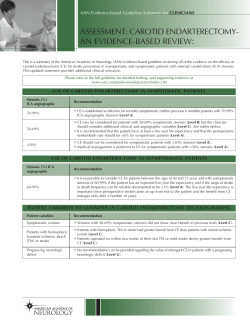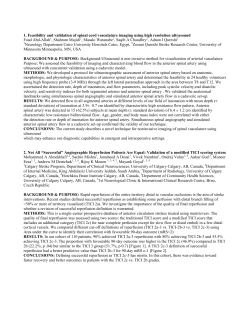
Bilateral anterior cerebral artery infarction resulting from explosion-type injury to... and neck.
Bilateral anterior cerebral artery infarction resulting from explosion-type injury to the head and neck. J H Lipschutz, R M Pascuzzi, J Bognanno and T Putty Stroke. 1991;22:813-815 doi: 10.1161/01.STR.22.6.813 Stroke is published by the American Heart Association, 7272 Greenville Avenue, Dallas, TX 75231 Copyright © 1991 American Heart Association, Inc. All rights reserved. Print ISSN: 0039-2499. Online ISSN: 1524-4628 The online version of this article, along with updated information and services, is located on the World Wide Web at: http://stroke.ahajournals.org/content/22/6/813 Permissions: Requests for permissions to reproduce figures, tables, or portions of articles originally published in Stroke can be obtained via RightsLink, a service of the Copyright Clearance Center, not the Editorial Office. Once the online version of the published article for which permission is being requested is located, click Request Permissions in the middle column of the Web page under Services. Further information about this process is available in the Permissions and Rights Question and Answer document. Reprints: Information about reprints can be found online at: http://www.lww.com/reprints Subscriptions: Information about subscribing to Stroke is online at: http://stroke.ahajournals.org//subscriptions/ Downloaded from http://stroke.ahajournals.org/ by guest on June 9, 2014 813 Case Report Bilateral Anterior Cerebral Artery Infarction Resulting From Explosion-Type Injury to the Head and Neck Joshua H. Lipschutz, MD; Robert M. Pascuzzi, MD; James Bognanno, MD; and Tim Putty, MD A 43-year-old woman suffered a blast-type injury to the head and neck. She subsequently developed bilateral internal carotid artery occlusion and bilateral anterior cerebral artery infarction not demonstrated by magnetic resonance imaging scan 24 hours after the explosion, but confirmed by a second scan 8 days after the explosion. In patients with blast-type injury to the head and neck who develop coma with a nonfocal neurological exam, the possibility of bilateral carotid artery occlusion and bilateral ischemic infarction should be considered. C arotid artery occlusion is a well-recognized, although infrequent, complication of nonpenetrating trauma to the head and neck.1-3 We report a patient who suffered a blast-type injury to the head and neck and subsequently developed bilateral internal carotid artery occlusion and bilateral anterior cerebral artery infarction. Case Report A 38-year-old woman with a history of mild hypertension and Graves' disease was preparing Christmas dinner for her family when, in attempting to light her gas stove, the stove exploded, producing minor burns to her neck, face, and scalp. There was no loss of consciousness. She was noted initially to be fully alert and neurologically intact, with first- and seconddegree burns on the face, ears, scalp, posterior neck, and upper back estimated to cover approximately 4% of the total body surface area. Eleven hours after the explosion, she became acutely unresponsive and developed episodic decerebrate posturing with episodic hypertension. She had slow roving conjugate eye movements, normal pupillary reaction, normal funduscopic examination, and symmetric lower cranial nerve function. Bilateral limb hypertonia, hyperactive reflexes, and extensor toe signs were present. Emergency computed tomogram of the head with and without contrast was normal. An electroencephalogram showed mild diffuse slowing. Intracranial pressure, cerebrospinal fluid profile, screens From the Departments of Internal Medicine (J.H.L.), Neurology (R.M.P.), Radiology (J.B.), and Neurosurgery (T.P.), Indiana University School of Medicine, Indianapolis, Ind. Address for correspondence: Robert M. Pascuzzi, MD, 1001 W. 10th St., 6th Floor, Indianapolis, IN 46202. Received November 5, 1990; accepted March 1, 1991. for metabolic disturbance, standard toxicological screens, Westergren sedimentation rate, antinuclear antibodies, thryoid function tests, blood cultures, and echocardiogram were all within normal limits. Magnetic resonance imaging was performed 24 hours after the explosion and was read initially as normal, although, in retrospect, there was a faintly increased signal in the cortical gray matter of the anterior cerebral artery distribution. A single photon emission computed tomogram 4 days after the explosion showed bifrontal perfusion defects. A second magnetic resonance imaging scan 8 days after the explosion showed large bilateral frontal and parasaggital abnormalities indicative of acute ischemic infarction in the anterior cerebral artery distribution (Figure 1). Mild abnormalities were seen in patchy fashion in territories supplied by the lenticulostriate arteries. A cerebral angiogram demonstrated narrow internal carotid arteries distal to the carotid bifurcation, with abrupt occlusion of the internal carotid arteries bilaterally just distal to the ophthalmic arteries (Figure 2). Over the next 4 weeks, the patient's neurological status remained unchanged. She became septic from a urinary tract infection and died 7 weeks after the explosion. Discussion Carotid artery occlusion due to nonpenetrating trauma is uncommon and was first described by Verniel in 1872.4 Although carotid arterial trauma accounts for approximately 10% of all arterial injuries in both civilian2 and military practice,1 only 3-5% of carotid arterial injuries are due to nonpenetrating trauma. Rubio and associates5 reviewed 72 Downloaded from http://stroke.ahajournals.org/ by guest on June 9, 2014 814 Stroke Vol 22, No 6 June 1991 FIGURE 1. Long repetition time, long echo time axial magnetic resonance image obtained on day 8. Extensive symmetric edema in the anterior cerebral artery distribution and the lenticulostriate distributions, right greater than left (arrows). cases of carotid arterial trauma in which only two were caused by nonpenetrating injuries. Accurate diagnosis of carotid arterial injury due to nonpenetrating trauma at the time of hospital presentation is difficult. In a compilation of 96 cases by Krajewski and Hertzer,6 only 6% of the patients with carotid arterial injury due to nonpenetrating trauma had symptoms within 1 hour after injury. Most developed symptoms within 24 hours, but 17% had no symptoms for days or weeks after the injury. Symptoms included aphasia, altered consciousness, seizures, and motor and sensory disturbances. Bilateral anterior cerebral artery occlusion with resultant frontal lobe lesions, as occurred with our patient, can produce akinetic mutism7 and coma.8 Although the lesions are primarily in the frontal lobes, they may result in more widespread disruption of hemispheric function. Plum and Posner8 note that large, deep, midline frontal lesions in humans interrupt the major reciprocal pathways that interconnect the frontal lobe with the thalamus, the amygdala, and the midbrain. Such interruptions not only affect frontal lobe function directly but secondarily influence large parts of the remaining neocortex that normally receive cortical-cortical connections and limbic modulation transmitted via the frontal lobe.8 These effects could account for the coma seen in our patient. The source of trauma is probably the principal factor that determines the site of carotid injury.6 A blow to the head initiating sudden hyperextension and rotation or lateral flexion can stretch the distal internal carotid artery across the transverse processes of the first three cervical vertebrae, leading to distal internal carotid arterial injury. This occurs more commonly in young people, probably because of the fact that in elderly patients, the carotid arteries are more tortuous and tend to straighten rather than stretch when sudden hyperextension and rotation occurs.1 Focal disruption of the intima providing a nidus for thrombus formation may be the mechanism for carotid arterial occlusion after nonpenetrating trauma, especially when the injury involves sudden hyperextension of the neck.9 Our patient may have suffered sudden hyperextension of the neck caused either by the force of the blast or as a reaction to the blast. The symmetry of the force could account for the bilaterality of the internal carotid arterial occlusion. Internal carotid arterial dissection could have Downloaded from http://stroke.ahajournals.org/ by guest on June 9, 2014 Lipschutz et al Bilateral Anterior Cerebral Artery Infarction 815 FIGURE 2. Late phase of the left internal carotid angiogram (day 10). Occlusion of the internal carotid artery just distal to the ophthalmic artery is present (arrow). Collateral filling of the anterior falx artery via ethmoidal branches of the ophthalmic artery is present (arrowheads). Some reflux into the external carotid circulation was encountered (open arrows). occurred in our patient even though it was not demonstrated on the angiogram. Several features of this case are noteworthy. Bilateral internal carotid arterial occlusion is rare and, to our knowledge, has never been described in the setting of a blast-type injury. In a review by Scherman and Tucker,3 only 11 cases of bilateral internal carotid arterial occlusion have been reported, and in only two of these was there complete occlusion of both internal carotid arteries, as occurred with our patient. Additionally, our patient had extensive bilateral anterior cerebral artery infarction in association with the carotid arterial occlusion. Acute internal carotid arterial occlusion more commonly produces a middle cerebral artery infarction rather than an anterior cerebral artery infarction.1'2 The reason for the anterior cerebral artery involvement in our case is unclear. Acute thrombus in the internal carotid artery may have embolized into the anterior cerebral artery. Alternatively, acute internal carotid arterial occlusion may have produced anterior and middle cerebral artery involvement, with the latter having sufficient collateral blood flow to limit the infarction to the anterior cerebral artery territory. Regarding treatment, when the diagnosis is delayed and the ischemic infarction completed, as occurred with our patient, there is little to be gained from carotid reconstruction, and hemorrhagic cerebral infarction could occur after revascularization.6 Although acute heparinization shortly after the detection of carotid arterial injury might logically limit the propagation of thrombus, several anecdotal reports of subarachnoid hemorrhage as well as progres- sion of ischemic deficit during treatment suggest caution with early anticoagulation.10 In summary, in patients who suffer a blast-type injury to the head and neck and who subsequently develop coma with a nonfocal neurological exam, the possibility of bilateral carotid artery occlusion and bilateral ischemic infarction should be considered in the differential diagnosis. References 1. Davis JM, Zimmerman RA: Injury of the carotid and vertebral arteries. Neuroradiology 1983;25:55-69 2. Mooney RP, Bessen HA; Delayed hemiparesis following nonpenetrating carotid artery trauma. Am J Emerg Med 1988;6: 341-345 3. Scherman BM, Tucker WS: Bilateral traumatic thrombosis of the internal carotid arteries in the neck: A case report with review of the literature. Neurosurgery 1982;10:751-753 4. Verniel M: Contusion multiples; delire violent; hemiplegie a droite, signes de compression cerebrale. De LAcademie De Medicine (Paris) 1872;l:46-56 5. Rubio PA, Ruel GJ, Beall AC Jr, Jordan GL Jr, DeBakey ME: Acute carotid artery injury: 25 years experience. / Trauma 1974; 14:967-973 6. Krajewski LP, Hertzer NR: Blunt carotid artery trauma: Report of two cases and review of the literature. Ann Surg 198O;191:341-346 7. Freemon FR: Akinetic mutism and bilateral anterior cerebral artery occlusion. / Neurol Neurosurg Psychiatry 1971;34: 693-697 8. Plum F, Posner J: The pathologic physiology of signs and symptoms of coma, in The Diagnosis of Stupor and Coma, ed 3. Philadelphia, FA Davis Co, 1982, pp 24-26 9. Crissey MM, Bernstein EF: Delayed presentation of carotid intimal tear following blunt craniocervical trauma. Surgery 1974;75:543-549 10. Hart RG, Easton JD: Dissections and trauma of cervicocerebral arteries, in Barnett HJM, Mohr JP, Stein BM, Yatsu FM (eds): Stroke: Pathophysiology, Diagnosis, and Management New York, Churchill Livingstone, Inc, 1986, pp 775-788 KEY WORDS • carotid artery diseases • cerebral infarction Downloaded from http://stroke.ahajournals.org/ by guest on June 9, 2014
© Copyright 2025





















